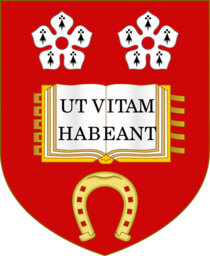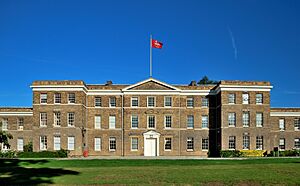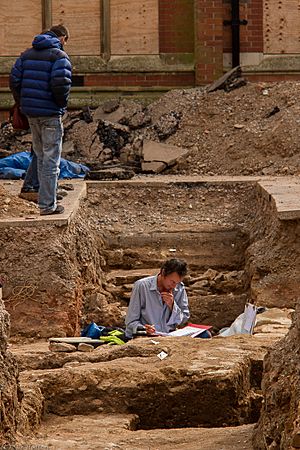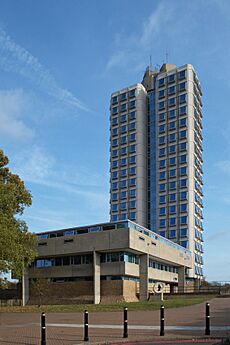University of Leicester facts for kids
The University of Leicester is a public research university located in Leicester, England. Its main campus is just south of the city centre, next to Victoria Park. The university started as 'University College, Leicester' in 1921 and became a full university in 1957.
The University of Leicester is famous for some amazing discoveries! It's where genetic fingerprinting was invented. This is a special way to identify people using their DNA. The university also helped find and identify the bones of Richard III in Leicester, a king who died a long time ago.

Shield of the University of Leicester
|
||||||||||||
| Motto | Latin: Ut Vitam Habeant | |||||||||||
|---|---|---|---|---|---|---|---|---|---|---|---|---|
|
Motto in English
|
So that they may have life | |||||||||||
| Type | public research university | |||||||||||
| Established |
|
|||||||||||
| Endowment | £23.6 million (2023) | |||||||||||
| Budget | £368.0 million (2022/23) | |||||||||||
| Chancellor | Dame Maggie Aderin-Pocock | |||||||||||
| Vice-Chancellor | Nishan Canagarajah | |||||||||||
| Visitor | The King | |||||||||||
|
Academic staff
|
1,655 (2021/22) | |||||||||||
|
Administrative staff
|
2,060 (2021/22) | |||||||||||
| Students | 16,670 (2021/22) | |||||||||||
| Undergraduates | 11,315 (2021/22) | |||||||||||
| Postgraduates | 5,355 (2021/22) | |||||||||||
| Location |
,
England, UK
52°37′17″N 1°07′28″W / 52.62139°N 1.12444°W |
|||||||||||
| Campus | Urban parkland | |||||||||||
| Colours |
|
|||||||||||
| Affiliations |
|
|||||||||||
 |
||||||||||||
Contents
History of the University
How the University Started
People in Leicester started talking about having their own university in the late 1800s. Other cities like Manchester and Birmingham already had universities. It was thought that Leicester should have one too.
Dr. Astley V. Clarke brought up the idea again in 1912. But then First World War started in 1914, and plans were put on hold. After the war ended, people wanted to create something special to remember those who had died. A university college seemed like a great idea.
Building the College
A rich businessman named Thomas Fielding Johnson bought a large piece of land and a building for £40,000. He wanted to use it for the new college. Many other people also donated money, often in memory of loved ones lost in the war. King George V supported the plan in 1919.
The college officially opened in October 1921. It had a principal, a secretary, three teachers, and just nine students! Most of the first students were women. The college aimed to train teachers and help students prepare for degrees from the University of London.
In 1932, Frederick Attenborough became the principal. He was the father of famous brothers David and Richard Attenborough.
Becoming a University
In 1957, the University College was officially given the right to be a full university. This meant it could award its own degrees. The student union building, called Percy Gee, was opened by Queen Elizabeth II in 1958.
Leicester University won the first ever series of University Challenge in 1963. The university's motto is Ut Vitam Habeant, which means "so that they may have life." This motto reflects its origins as a memorial after the war.
The university's medical school opened in 1971. In 1994, the university won the Queen's Anniversary Prize for its amazing work in Physics and Astronomy.
In 2012, a team from the university found the body of King Richard III in Leicester. This was a huge discovery! They found him buried under a car park, which used to be a church.
In 2017, some Physics students from the university made news for calculating how long it would take a zombie apocalypse to wipe out humanity. They predicted it would take just 100 days!
University Campus

The main campus is about a mile south of the city centre. You can see three tall, unique buildings from the 1960s that stand out in the skyline. These are the Engineering Building, the Attenborough Tower, and the Charles Wilson Building.
Fielding Johnson Building
The Fielding Johnson Building was built in 1837. It was originally a hospital. From 1921, it was home to most of the university's departments. Today, it holds the university's main offices and the Law faculty.
Attenborough Tower
The Attenborough Tower is 18 stories tall. It is home to many of the university's social sciences departments. It has been updated recently.
Engineering Building
The Engineering Building was designed by famous architects James Stirling and James Gowan. It's a special building, listed for its important design. It has workshops, labs, offices, and lecture halls.
Other Important Buildings

- The Astley Clarke Building is home to the School of Media.
- The Ken Edwards Building, built in 1995, houses the School of Management.
- The Percy Gee Building is where the Students' Union is located.
- The David Wilson Library was opened by Queen Elizabeth II in 2008 after a big renovation.
- The George Davies Centre, built in 2016, is home to Leicester's Medical School.
- The Attenborough Arts Centre is the university's arts centre.
Many of the university's student halls of residence are in Oadby. They used to be the homes of rich factory owners from Leicester.
What You Can Study
The university has different colleges, each with many schools and departments.
College of Life Sciences
This college includes:
- Leicester Medical School
- School of Biological Sciences
- School of Psychology
They also have research groups that study things like heart health, genetics, and how the body fights infections.
Leicester Medical School
The university has a large medical school that opened in 1971. It helps train new doctors.
College of Science and Engineering
This college includes departments like:
- Chemistry
- Informatics (computer science)
- School of Geography, Geology & the Environment
- Engineering
- Physics and Astronomy
They also have special research centres for space, climate change, and advanced microscopy.
Physics and Astronomy
This department has hundreds of students studying physics and astronomy. It has research groups for space science, X-ray astronomy, and theoretical astrophysics. The department also has a large telescope at the University of Leicester Observatory. They work closely with the National Space Centre in Leicester.
College of Social Sciences, Arts and Humanities
This college has many schools, including:
- American Studies
- Archaeology and Ancient History
- School of Business
- Criminology
- Education
- History, Politics and International Relations
- Leicester Law School
- School of Media, Communication and Sociology
- Museum Studies
Archaeology and Ancient History
This school studies ancient times and digs up old sites. They are known for their work on Mediterranean archaeology and the archaeology of more recent periods. This is the team that found King Richard III's bones!
Business
The School of Business was created in 2016. It offers degrees in Management, Accounting, and Economics. It is one of the top business schools in the world.
English
The School of English teaches about English language and literature, from old texts to modern writing. It has the first Victorian Studies Centre in the UK.
Law
The School of Law is one of the biggest departments at the university. It is considered one of the top law schools in the country.
University Life
The university has a lively student life with over 220 different student societies. These are groups where students can share hobbies and interests.
Student Media
Students at Leicester run their own media groups:
- Leicester Student Magazine: This magazine was started in 1957.
- Galaxy Radio: This radio station is run by students and plays music, has chat shows, and news. They also do a yearly 24-hour charity broadcast.
- LUST (Leicester University Student Television): This TV station is run by students.
Famous People from Leicester University
Many famous people have studied or worked at the University of Leicester.
- Sir Alec Jeffreys invented genetic fingerprinting here.
- Anthony Giddens is a famous sociologist.
- Sir Liam Donaldson was a Chief Medical Officer.
- Natalie Bennett was a leader of the Green Party.
- Bob Mortimer is a well-known comedian.
- C. P. Snow was a famous author.
The Attenborough Family
The University of Leicester has a special connection to the Attenborough family. Richard Attenborough (a famous actor and director) and David Attenborough (a famous naturalist and TV presenter) grew up in College House, which is now part of the university. Their father, Frederick Attenborough, was the principal of the university college for many years.
Both brothers have kept strong links with the university. David Attenborough has an honorary degree and opened the Attenborough Arboretum. The Richard Attenborough Centre for Disability and the Arts was also named after his brother.
Images for kids
-
The Engineering Building, designed by James Stirling, James Gowan and Frank Newby
-
Vaughan College, the university's former adult education college, is Grade II listed and faces the Jewry Wall Roman ruins
-
Anthony Giddens, sociologist
-
Natalie Bennett, British politician
See also
 In Spanish: Universidad de Leicester para niños
In Spanish: Universidad de Leicester para niños
















